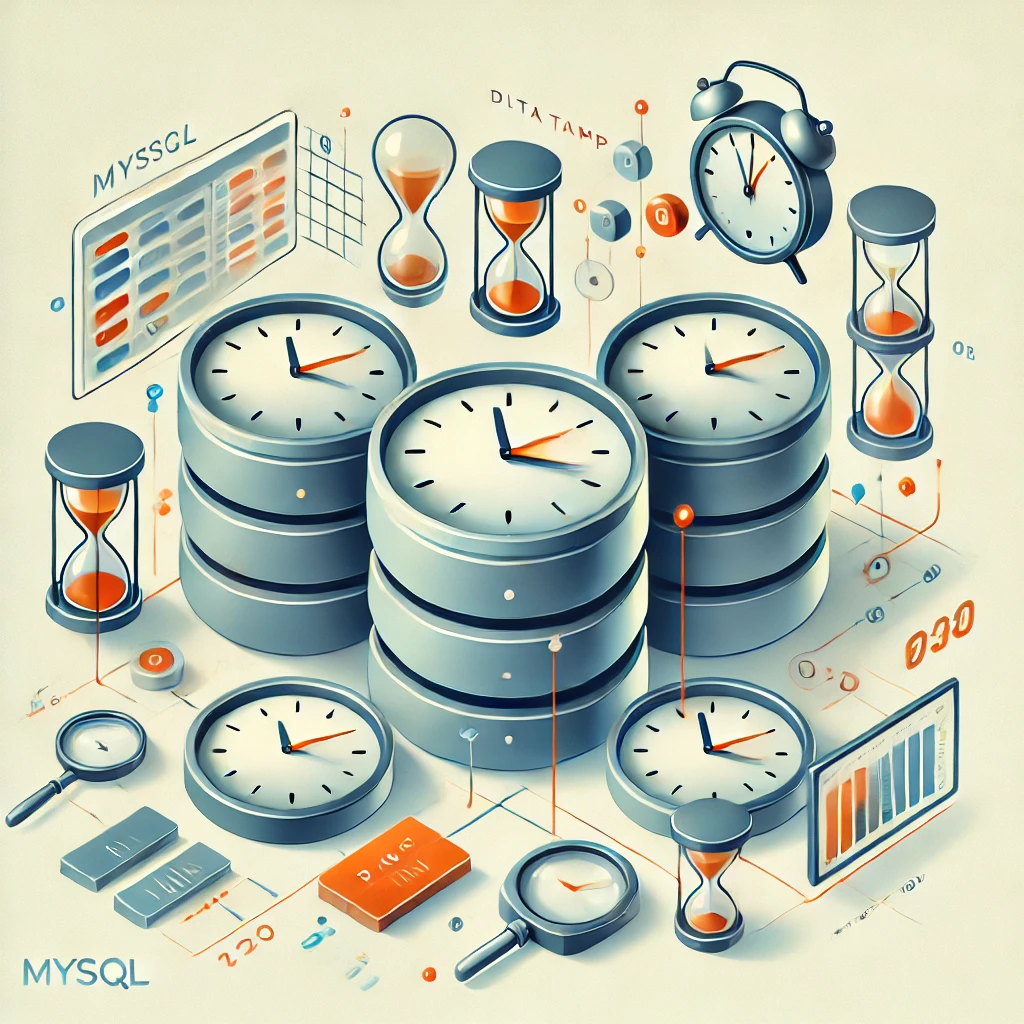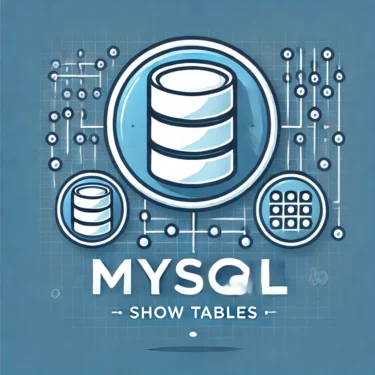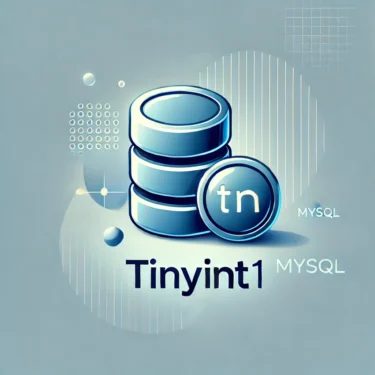1. What is a MySQL TIMESTAMP?
In MySQL, the TIMESTAMP data type stores a specific point in time in UTC (Coordinated Universal Time) and automatically adjusts for the time zone during storage and retrieval. This data type can handle dates and times ranging from January 1, 1970, to January 19, 2038. When data is stored, TIMESTAMP uses the current time zone, and upon retrieval, it is automatically converted back based on the system time zone.
Difference Between TIMESTAMP and DATETIME
The DATETIME data type is often compared to TIMESTAMP. Unlike TIMESTAMP, DATETIME stores date and time exactly as entered, without time zone conversions. In contrast, TIMESTAMP is converted to UTC upon storage and then adjusted back to the system’s time zone upon retrieval, helping to prevent discrepancies across time zones.
For example, TIMESTAMP is especially useful when migrating systems or managing databases across multiple time zones. Meanwhile, DATETIME supports a much wider range—from the year 1000 to 9999—making it suitable for avoiding the Year 2038 problem.
Example of Using TIMESTAMP
You can create a table with a TIMESTAMP column as shown below:
CREATE TABLE events (
id INT AUTO_INCREMENT PRIMARY KEY,
event_time TIMESTAMP DEFAULT CURRENT_TIMESTAMP ON UPDATE CURRENT_TIMESTAMP
);In this example, the event_time column automatically stores the current time when a record is inserted and updates the timestamp whenever the record is modified.
2. Basic Usage of TIMESTAMP
When using TIMESTAMP in MySQL, it’s important to know the basic methods for inserting and retrieving values. Below are several examples of working with TIMESTAMP.
Insert a Specific Date and Time
When inserting data into a TIMESTAMP column, you usually provide the date and time as a string in the format YYYY-MM-DD hh:mm:ss.
INSERT INTO events (event_time) VALUES ('2023-10-01 12:30:00');This SQL statement inserts October 1, 2023, at 12:30 PM into the event_time column.
Insert the Current Time
Using MySQL’s NOW() function, you can easily insert the current date and time. This function returns the current system time based on the configured time zone.
INSERT INTO events (event_time) VALUES (NOW());In this case, the query inserts the exact current timestamp at the moment the SQL runs.
Enable Automatic Updates
By adding ON UPDATE CURRENT_TIMESTAMP to a TIMESTAMP column, MySQL automatically updates the column value whenever the record is modified.
CREATE TABLE orders (
id INT AUTO_INCREMENT PRIMARY KEY,
order_time TIMESTAMP DEFAULT CURRENT_TIMESTAMP ON UPDATE CURRENT_TIMESTAMP
);Here, order_time stores the current timestamp when the record is first created and updates whenever the row is modified.
3. Working with TIMESTAMP and Time Zones
One of the main features of TIMESTAMP is its handling of time zones. Stored data is always converted to UTC, and upon retrieval, it is converted back based on the system time zone.
Checking Time Zone Settings
In MySQL, time zones can be set per server or session. You can check the current setting using:
SHOW VARIABLES LIKE 'time_zone';To change the time zone, you can use:
SET time_zone = '+09:00';TIMESTAMP vs. DATETIME in Time Zones
DATETIME ignores time zones and stores values exactly as entered, while TIMESTAMP converts to UTC. This makes TIMESTAMP better suited for systems operating across multiple time zones.
4. The Year 2038 Problem
The Year 2038 problem arises from the limitations of 32-bit systems with TIMESTAMP. Since it counts seconds from January 1, 1970, it overflows after January 19, 2038, at 03:14:07 UTC.
How to Avoid the 2038 Problem
To avoid this, use a 64-bit system or switch to DATETIME, which supports years 1000 through 9999. System upgrades to 64-bit also eliminate the issue entirely.
5. Practical Uses of TIMESTAMP
MySQL’s TIMESTAMP is not only for storing dates and times but also for automatically recording creation and update times. Some use cases include:
Automatically Insert Current Time
CREATE TABLE orders (
id INT AUTO_INCREMENT PRIMARY KEY,
order_time TIMESTAMP DEFAULT CURRENT_TIMESTAMP
);Automatically Update Timestamps
CREATE TABLE users (
id INT AUTO_INCREMENT PRIMARY KEY,
username VARCHAR(50),
updated_at TIMESTAMP DEFAULT CURRENT_TIMESTAMP ON UPDATE CURRENT_TIMESTAMP
);Using Multiple TIMESTAMP Columns
Although you can have multiple TIMESTAMP columns in a table, only one can have CURRENT_TIMESTAMP as the default. For multiple auto-managed date fields, you may need to use DATETIME or explicitly set values.
CREATE TABLE posts (
id INT AUTO_INCREMENT PRIMARY KEY,
created_at TIMESTAMP DEFAULT CURRENT_TIMESTAMP,
updated_at TIMESTAMP DEFAULT CURRENT_TIMESTAMP ON UPDATE CURRENT_TIMESTAMP
);6. Things to Keep in Mind When Using TIMESTAMP
NULL Constraints and Default Values
TIMESTAMP columns are NOT NULL by default. To allow NULL values, specify DEFAULT NULL.
CREATE TABLE logs (
id INT AUTO_INCREMENT PRIMARY KEY,
log_time TIMESTAMP DEFAULT NULL
);The 0000-00-00 00:00:00 Issue
Older versions of MySQL may allow 0000-00-00 00:00:00 as an invalid timestamp. However, this can cause integrity issues and is discouraged. Instead, use NULL or a valid default.
System Time Zone Impact
Because TIMESTAMP always stores UTC, migrating databases across servers with different time zones can affect results. Always ensure consistent time zone management.
7. Summary and Recommendations
TIMESTAMP is a powerful MySQL tool for managing dates and times efficiently. Its auto-conversion with time zones and auto-update features make it highly convenient. However, developers must understand its limitations such as the Year 2038 problem and NULL handling.
- Use
TIMESTAMPwhen automatic updates are required. - Choose
TIMESTAMPfor time zone–sensitive systems. - Use
DATETIMEfor long-term data beyond 2038 or when absolute consistency is needed.
8. Frequently Asked Questions (FAQ)
When should I use TIMESTAMP vs. DATETIME?
Use TIMESTAMP for systems needing time zone adjustments and automatic recording of creation/update times. Use DATETIME when you want consistent storage unaffected by time zones.
Is it true TIMESTAMP won’t work after 2038?
Yes, on 32-bit systems, TIMESTAMP overflows after January 19, 2038. To prevent issues, use DATETIME or migrate to a 64-bit system.
How do I allow NULL values in a TIMESTAMP column?
Explicitly set DEFAULT NULL when creating the column:
CREATE TABLE logs (
id INT AUTO_INCREMENT PRIMARY KEY,
log_time TIMESTAMP DEFAULT NULL
);Does changing the time zone affect existing TIMESTAMP data?
The stored data remains in UTC, but retrieval adjusts to the new time zone setting, which changes how times are displayed. Keep system time zones consistent to avoid confusion.
Can I insert a specific time if I use CURRENT_TIMESTAMP?
Yes. While CURRENT_TIMESTAMP inserts the current system time, you can still manually insert specific values:
INSERT INTO events (event_time) VALUES ('2023-10-01 12:30:00');


